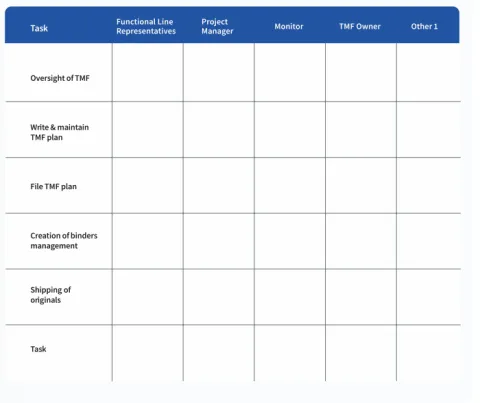
5 Steps to Building a Shared Responsibility Model for eTMF

Managing the trial master file (TMF) for a clinical trial is a lot of work. Often, sponsors will delegate TMF management to a contract research organization (CRO). But the truth is, the sponsor can never completely outsource the TMF – ultimately, it is the Sponsor who is legally responsible for maintaining a complete TMF, so the CRO and the Sponsor need to collaborate. That’s where a shared or hybrid management approach comes into play.
Our customer, DZS Clinical Services, is no stranger to supporting sponsors in the management of the TMF. And with the help of an eTMF (electronic trial master file), the two groups can work together to create a shared responsibility that ensures the successful management of the TMF throughout the entire clinical trial. DZS offered five steps to building this shared responsibility model.
- Create a Roles & Responsibilities Document or Checklist
- Document an eTMF Plan
- Set Up the eTMF System
- Set Up eISF for Sites to Manage their Documentation
- Ensure Data Integrity / Quality Management Throughout the Trial
Create a Roles & Responsibilities Document or Checklist
The first thing you need to do is define the roles and responsibilities of your team.
Here are the most common team roles involved with managing the TMF:
- Functional Line Representative: A functional line representative is similar to a service area representative or business unit/department member. This person is assigned specific TMF responsibilities according to their functional role.
- Project Manager: The project manager oversees the setup and management of the TMF, ensuring everything is in place in a timely manner.
- Monitor: The monitor(s) oversees the progress of a trial, ensuring the correct documents are recorded and reported on according to the protocol, standard operating procedures, GCP guidelines, and regulatory requirements.
- TMF Owner: What role does the sponsor (the TMF owner) play in managing the TMF?
There may also be additional roles that need to be involved, so use this as your starting point.
Assigning Tasks (Responsibilities)
Once you identify your team, you need to assign tasks to each one. In addition to these roles, you may identify additional team members that need to be involved in TMF management. Some of these tasks include:
- Oversight of the TMF
- Write and maintain the TMF plan
- File TMF plan
- User access management
- Binder creation
- Shipping original documents
- Destruction of paper copies
- Filing documents in the TMF
- Paper Reconciliation
- Ongoing checks by CRO
- Data Integrity Check (QA/QC)
- Ongoing checks by the sponsor
- Readiness review
- Issue resolution
- Progress reports
- Archiving
- Trend analysis and action plan
- TMF transfer
For each role defined, you will assign one or more of tasks from the list above and others. Your table would look something like this:

Document an eTMF Plan
The next step is to document an eTMF Plan. Add a section to the Trial Master Plan or create a separate document and include the following information:
- TMF Oversight & Access Arrangements – Who will oversee the TMF, and how will team members access it?
- TMF Content – What documents go into the TMF, and how are they organized?
- Quality Assurance – What is the QA process, and how are issues resolved?
- Record and TMF Disposition – What is the process to record documents in the TMF – both sponsor and investigator TMF?
- Applicable SOPs – What are the SOPs applicable to the trial?
- TMF Training – Who needs to be trained on the TMF, and how/where will the training take place?
- Conducting TMF Reviews – Who will conduct regular TMF reviews, and what does the process look like?
- Transfers of TMF – What is the process to transfer documents from sites to the TMF and the TMF contents to the sponsor during and at the close of the trial?
“Standardization is key to quality, and the eTMF Plan is the guiding document to standardization. It can mitigate risks to data integrity and participant safety by improving the organization and quality of critical documents and reducing variability in the process.”
– Kari Brown, Director, Clinical Operations, DZS Clinical.
Set Up the eTMF Application
Step three involves setting up the actual eTMF application. Each eTMF application will have different implementation guides, so to help you understand what may be involved, we’ll describe the process of implementing Agatha Clinical (eTMF).
- Provision of the Agatha Clinical TMF environment
- Set up initial users in Agatha with the correct role and access
- Determine TMF Structure
- Review standard TMF Reference Model content and identify any additions or deletions for the customer’s needs
- Create a standard template for the customer’s TMF model
- Create a Study Workspace
- Configure the workspace for customer-specific processes such as user roles and access and workflow processes
- Update User Acceptance Tests to reflect configurations
- Execute UAT and Sign Validation Documents
- Train Users to use the application
- Implement in Production
Set Up the eISF for Sites to Manage their Documentation
Now it’s time to help the Sites prepare to manage their TMF-required documentation. To do this requires providing Sites with their own application, called the Investigator Site File (ISF). In this case, Agatha Remote ISF is an application that Sites can use to upload their documents for review and inspection by the CRO and sponsor.
With an eISF, TMF administrators create separate, secure areas for each site to manage their documentation. Both site personnel and the monitor have access to the eISF to manage and review site documents.
The eTMF and the eISF should be integrated to allow for a seamless flow of final documents from eISF to the eTMF. For example, Agatha Remote ISF is integrated with Agatha Clinical to ensure the required ISF documents can be added to the TMF when they are reviewed and approved.
You can learn more about Agatha Remote ISF here.
Ensure Data Integrity / Quality Management Throughout the Trial
Managing user access to the eTMF and eISF throughout the trial is crucial for the quality management of the systems. Therefore, this aspect of the eTMF and eISF needs to be well documented and managed throughout the trial to ensure appropriate access rights are provided in a timely manner and remove access rights when needed.
In addition, the flow of communication for notification to the system administrator of staffing changes should be well documented in the eTMF Plan. Quality control (QC) review of individual documents in the eTMF/eISF and the review of the eTMF as a whole should be performed at intervals designated in the eTMF Plan. Responsibility for these tasks should be documented, and appropriate personnel should be trained on their specific role(s).
Many sponsors and CROs manage QC using spreadsheets, but there is an easier way. With Agatha Clinical, there is a built-in QC check capability that helps track documents that have been QC’d and the result. As the QC process continues and documents are approved, there is full auditing of all activities, so it’s easy to see what happened to a document and by whom.
Ready to Learn More?
There are five steps to building a shared responsibility model for the eTMF. You can learn more by downloading the full whitepaper co-authored by DZS Clinical Services and Agatha. Or you can watch the on-demand recording of a webinar we did together on this topic.
Ready do dive in?
For inquiries about our products and services, or to sign up for a demo, click here.
